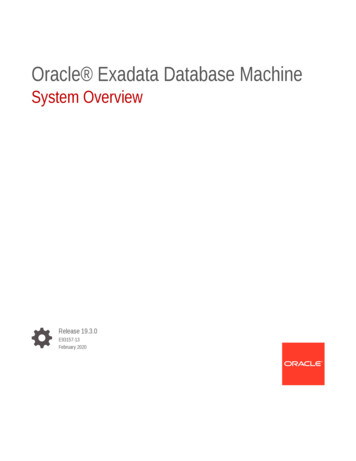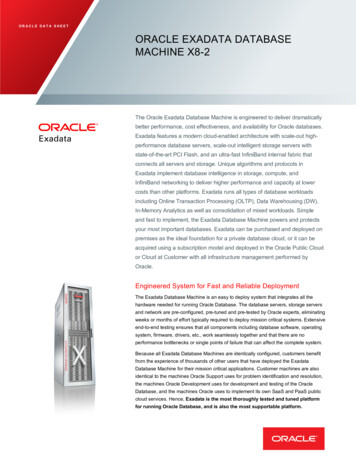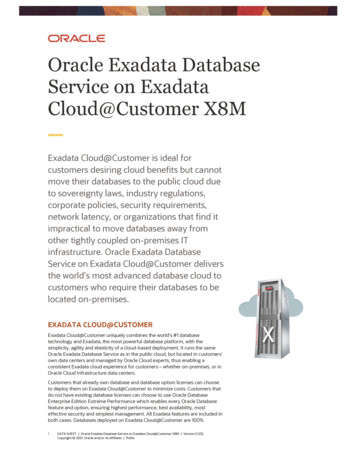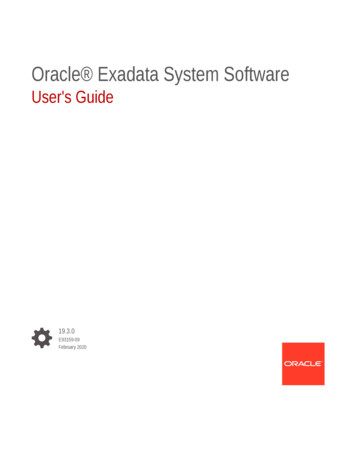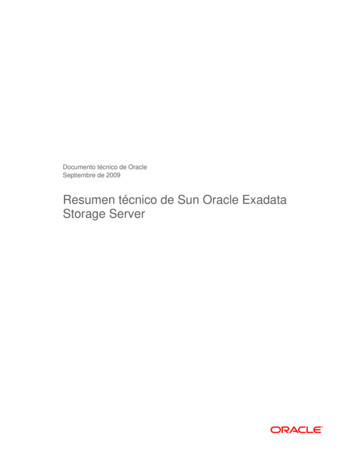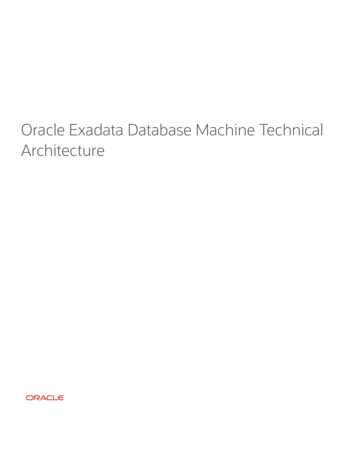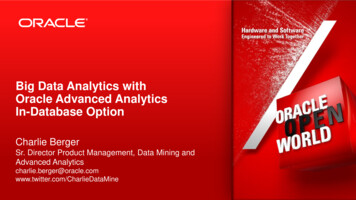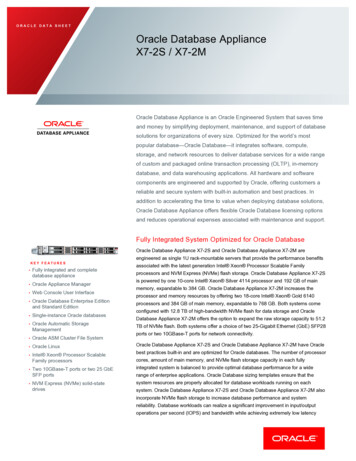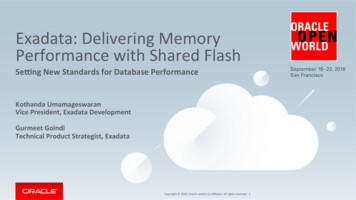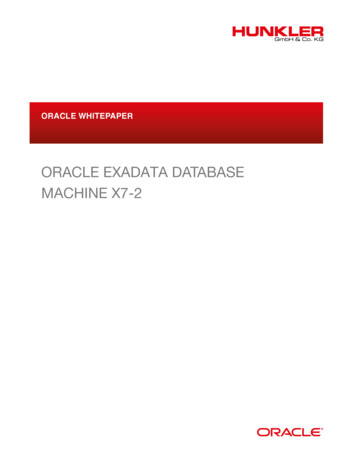
Transcription
ORACLE WHITEPAPERORACLE EXADATA DATABASEMACHINE X7-2
ORACLE DAT A SHEETORACLE EXADATA DATABASEMACHINE X7-2The Oracle Exadata Database Machine is engineered to deliver dramaticallybetter performance, cost effectiveness, and availability for Oracle databases.Exadata features a modern cloud-based architecture with scale-out highperformance database servers, scale-out intelligent storage servers withstate-of-the-art PCI flash, and an ultra-fast InfiniBand internal fabric thatconnects all servers and storage. Unique software algorithms in Exadataimplement database intelligence in storage, compute, and InfiniBandnetworking to deliver higher performance and capacity at lower costs thanother platforms. Exadata runs all types of database workloads includingOnline Transaction Processing (OLTP), Data Warehousing (DW), In-MemoryAnalytics as well as consolidation of mixed workloads. Simple and fast toimplement, the Exadata Database Machine powers and protects your mostimportant databases. Exadata can be purchased and deployed on premisesas the ideal foundation for a private database cloud, or can be acquiredusing a subscription model and deployed in the Oracle Public Cloud or Cloudat Customer with all infrastructure management performed by Oracle.Engineered System for Fast and Reliable DeploymentThe Exadata Database Machine is an easy to deploy system that includes all thehardware needed for running Oracle Database. The database servers, storage serversand network are pre-configured, pre-tuned and pre-tested by Oracle experts, eliminatingweeks or months of effort typically required to deploy a mission critical high performancesystem. Extensive end-to-end testing ensures all components including databasesoftware, OS, firmware, drivers, etc. work seamlessly together and there are noperformance bottlenecks or single points of failure that can affect the complete system.Because all Exadata Database Machines are identically configured, customers benefitfrom the experience of thousands of other users that have deployed the ExadataDatabase Machine for their mission critical applications including most of the top Banks,Telecoms, and Retailers in the world. Customer machines are also identical to themachines Oracle Support uses for problem identification and resolution, the machinesOracle Engineering uses for development and testing of Oracle Database, and themachines Oracle uses to implement its own SaaS and PaaS public cloud. Hence,Exadata is the most thoroughly tested and tuned platform for running OracleDatabase, and is also the most supportable platform.
ORACLE DAT A SHEETKEY FEATURES Up to 912 CPU cores and 28.5TB memory perrack for database processing Up to 360 CPU cores per rack dedicated toSQL processing in storage From 2 to 19 Database Servers per rack From 3 to 18 Storage Servers per rack Up to 920 TB of flash capacity (raw) per rack Up to 2.1 PB of disk capacity (raw) per rack Hybrid Columnar Compression often delivers10X-15X compression ratiosThe Oracle Exadata Database Machine runs the standard Oracle Database. Therefore,any application that uses the Oracle Database today can be easily and seamlesslymigrated to use the Exadata Database Machine with no changes to the application.Databases can also be easily migrated off of Exadata eliminating any fear of “lock-in”.Customers thinking of deploying databases on the Public Cloud, now or in the future, canbe confident that Exadata provides 100% compatibility between on-premises andpublic cloud enabling easy migration to the public cloud and simple hybrid clouddeployments. 40 Gb/second (QDR) InfiniBand Network Complete redundancy for high availabilityExtreme System Scalability and Growth with ElasticConfigurationsThe Exadata Database Machine uses a scale-out architecture for both databaseKEY BENEFITS Pre-configured, pre-tested system optimizedfor all database applications Uncompressed I/O bandwidth of up to 350GB/second per full rack from SQL Ability to perform up to 4.8M 8K database readI/O operations, or 4.3M 8K flash write I/Ooperations per second per full rack Easily add compute or storage servers to meetthe needs of any size application Scale by connecting multiple ExadataDatabase Machine X7-2 racks or ExadataStorage Expansion Racks. Up to 18 racks canbe connected by simply adding InfiniBandcables and internal switches. Largerconfigurations can be built with externalInfiniBand switchesservers and storage servers. As an Exadata Database Machine grows, databaseCPUs, storage, and networking can be added in a balanced fashion ensuring scalabilitywithout bottlenecks.The scale-out architecture accommodates any size workload and allows seamlessexpansion from small to extremely large configurations while avoiding performancebottlenecks and single points of failure.A high-bandwidth low-latency 40 Gb/second InfiniBand network connects all thecomponents inside an Exadata Database Machine. Specialized database networkingprotocols run over the InfiniBand network and provide much lower latency and higherbandwidth communication than is possible using generic communication protocols.This enables both faster response time for OLTP operations, and higher throughput foranalytic workloads. External connectivity to the Exadata Database Machine is providedusing standard 10 Gigabit or 25 Gigabit Ethernet.Exadata Database Machine is the most versatile database platform. The ExadataX7-2 Database Machine uses powerful database servers each with two 24-core x86processors and 384 GB of memory (expandable up to 1.5 TB). Exadata also uses scaleout, intelligent storage servers that appear in two configurations – High Capacity (HC) orExtreme Flash (EF). HC Storage Servers have four NVMe PCI Flash cards each with 6.4TB (raw) Exadata Smart Flash Cache and twelve 10 TB 7,200 RPM disks. EF StorageServers have an all-Flash configuration with eight NVMe PCI Flash drives, each with 6.4TB (raw) storage capacity. The starting configuration of an Exadata Database Machine“I would recommend Exadata as a platformfor performance, reliability and ease ofsupport. Those three things mean verymuch to me in my daily life.”- Richard EwaldSenior Technical ArchitectSprintconsists of two database servers and three storage servers, which can be elasticallyexpanded by adding more database and/or storage severs as requirements grow. Elasticconfigurations provide an extremely flexible and efficient mechanism to expandcomputing power and/or storage capacity to meet any business need.In addition to upgrading within a rack, multiple racks can be connected using theintegrated InfiniBand fabric to form even larger configurations. For example, a systemcomposed of four racks is simply four times as powerful as a single rack system providing quadruple the I/O throughput, quadruple the storage capacity, and quadruplethe processing power. It can be configured as a large single system or logicallypartitioned for consolidation of multiple databases. Scaling out is easy with Exadata2 ORACLE EXADATA DATABASE MACHINE X7-2
ORACLE DAT A SHEETDatabase Machine. Oracle Real Application Clusters (RAC) can dynamically add moreprocessing power, and Automatic Storage Management (ASM) can dynamically addmore storage capacity.RELAT ED PRODUCTS Oracle Database Exadata Cloud Service Oracle Database Exadata Cloud at Customer Oracle Exadata Database Machine X6-8 Oracle Exadata Storage Expansion Rack X7-2 Oracle Exadata Storage Server X7-2 PlusInfiniBand Infrastructure Oracle Exadata Database Server X7-2 PlusInfiniBand Infrastructure Oracle SuperCluster Oracle Database 11g and 12c Real Application Clusters Partitioning Multitenant Database In-Memory Advanced Compression Advanced Security Active Data Guard GoldenGate Real Application Testing OLAP Advanced Analytics Business IntelligenceFig 1: Elastic Scale-out to Multi-rack Exadata Enterprise Manager Oracle Linux Oracle Virtual MachineWhen even larger storage capacity is required, the Oracle Exadata Storage ExpansionRack is available. The Exadata Storage Expansion Rack enables you to grow thestorage capacity and bandwidth of any Exadata Database Machine. It is designed fordatabase deployments that require very large amounts of data including: historical orarchive data, backups, documents, images, XML, JSON and LOBs. The storageexpansion rack connects to the Exadata Database Machine using the integratedRELAT ED SERVICESInfiniBand fabric and is extremely simple to configure, as there are no LUNs or mountThe following services are available from Oracle:points. Storage is configured and added to a database online with a few simple Advanced Customer Services Oracle Premier Support for Systems Oracle Platinum Services Consulting Services Oracle University coursescommands. The starting configuration of the Oracle Exadata Storage Expansion Rackconsists of four storage servers and can be further expanded by adding additionalstorage servers.Exadata Database Machines protect your investment by allowing newer generationservers and storage to be deployed seamlessly into existing Exadata DatabaseMachines. Similarly, new software releases are compatible with most previousgeneration Exadata Database Machines.Extreme Flash Storage Server: Record-breaking I/OPerformanceExadata Extreme Flash (EF) Storage Server, first introduced with Exadata X5, is thefoundation of a database-optimized all-flash Exadata Database Machine. Each EF3 ORACLE EXADATA DATABASE MACHINE X7-2
ORACLE DAT A SHEETStorage Server contains eight 6.4 TB state-of-the-art Flash Accelerator F640 NVMe PCIflash drives, offering 51.2TB raw flash capacity per EF Storage Server. Exadata X7 usesstate-of-the-art flash technology for improved speed, power efficiency, and endurancecompared to previous generations of Flash. The enterprise grade flash used in ExadataX7 have an expected endurance of 8 years or more for typical database workloads. Thisis very different from consumer grade flash that can potentially experience performancedegradations or fail unexpectedly after a few years of usage. In addition, Exadatadelivers ultra-high performance by placing the flash devices directly on the high speedPCI bus rather than behind slow disk controllers and directors. Finally, Exadata flashuses state-of-the-art NVMe (Non-Volatile Memory Express) flash to achieve extremely“Oracle Exadata enabled seamless andrapid migration of our cloud-based,integrated business applications, requiredno major modifications, and helped usreduce costs. With Oracle, we dramaticallyimproved our batch processing speed by241x and overall system performance by 3x,enabling us to improve operating efficiencyfor our daily, critical tasks and to enhancecustomer service.”- Kyoji KatoExecutive Officer and GMDaiwa Houselow latency and CPU overhead.Flash performance is often limited and bottlenecked by traditional storage architecture. Incontrast, Exadata uses a combination of scale-out storage, InfiniBand networking,database offload, and PCI flash to deliver extremely high performance rates from flash. Atraditional full rack Exadata Database Machine X7-2, with 8 database servers and 14Extreme Flash storage servers, can achieve up to 350 GB per second of analytic scanbandwidth from SQL, and 0.25 ms Database I/O latency at 3.5 Million Flash IOPSwhen running database workloads. A slightly different full rack combination, with 10database servers and 12 Extreme Flash storage servers, can achieve up to 5.97 Millionrandom 8K database read and 5.4 Million random 8K flash write I/O operations persecond (IOPS), which is an industry record for database workloads.This performance is orders of magnitude faster than traditional storage arrayarchitectures, and is also much faster than current all-flash storage arrays. It is importantto note that these are real-world end-to-end performance figures measured running SQLworkloads with standard 8K database I/O sizes inside a single rack Exadata system.Storage vendor performance quotes are usually based on small I/O sizes and low-levelIO tools and therefore are many times higher than can be achieved from SQL.“Oracle Exadata Database Machine ishelping to transform our business. Our SAPenvironment, one of the world’s largest, cannow support twice as much throughput withimproved stability.”- Milt SimondsDirector, Enterprise Platform DeliveryAmerisourceBergen CorporationFig 2: Flash Accelerator PCIe Card4 ORACLE EXADATA DATABASE MACHINE X7-2
ORACLE DAT A SHEETHigh Capacity Storage Server: Tiered Disk and Flash DeliverCost of Disk with Performance of FlashThe second Exadata storage option is the Exadata X7-2 High Capacity (HC) StorageServer. This server includes twelve 10 TB SAS disk drives with 120 TB total raw diskcapacity. It also has four Flash Accelerator F640 NVMe PCIe cards with a total rawcapacity of 25.6 TB of flash memory. Exadata flash in a High Capacity Storage Servercan be used directly as flash disks, but is almost always configured as a flash cache(Exadata Smart Flash Cache) in front of disk storage since caching provides flash levelperformance for much more data than fits directly into flash.Exadata Smart Flash Cache automatically caches frequently accessed data whilekeeping infrequently accessed data on disk. This provides the performance of flash withthe capacity and low cost of disk. The Exadata Smart Flash Cache uniquelyunderstands database workloads and knows when to avoid caching data that thedatabase will rarely access or is too big to fit in the cache. For example, Exadata doesn’tcache I/Os caused by backups, large table scans, or temporary results that will be“We chose Oracle Exadata because itoffered a complete solution . we’ve createddaily financial reports 4x faster and liquidityrisk reports 7x faster to consistently meetour service-level agreement, improvedcredit risk management, and reduced ourdata center footprint.”- Vaibhav SamantSenior Vice President, ITHDFC Bank Ltd.quickly deleted. In addition to automatic caching, administrators can optionally provideSQL directives to ensure that specific tables, indexes, or partitions are preferentiallyretained in the flash cache. A single full rack Exadata Database Machine X7-2, with 8database servers and 14 High Capacity storage servers can achieve up to 350 GB persecond of analytic scan bandwidth from SQL, and up to 4.8 Million random 8K readI/O operations per second (IOPS) from SQL, and 0.25 ms I/O latency at 2.7 Millionflash IOPS when running database workloads.Exadata’s Smart Flash Cache is designed to deliver flash-level I/O rates and responsetimes for data that is many times larger than the physical flash capacity in the machineby moving active data into flash, while leaving cold data on disk. It is common for hitrates in the Exadata Smart Flash Cache to be over 95%, or even 99% in real-worlddatabase workloads even though flash capacity is more than 4 times smaller than diskcapacity. Such high flash cache hit rates mean that Exadata Smart Flash Cacheprovides an effective flash capacity that is many times larger than the physical flash.For example, a full rack Exadata Database Machine X7-2 with 8 database servers and14 High Capacity Storage Servers often has an effective flash capacity equal to theusable disk capacity of 500 TB.The Exadata Smart Flash cache also caches database block writes using Exadata WriteBack Flash Cache technology. Write caching eliminates disk bottlenecks in large scaleOLTP and batch workloads. The flash write capacity of a single full rack Exadata“None of the reports takes more than 10minutes. It was taking 3-4 hours before, nowit completes in 3 minutes. It sounds like unreal but it is real.”- Finance UserTurkcellDatabase Machine X7-2 with 8 database servers and 14 High Capacity Storage Serversexceeds 4.3 Million 8K write I/Os per second. The Exadata write cache is transparent,persistent, and fully redundant. The I/O performance of the Exadata Smart Flash Cacheis comparable to dozens of enterprise disk arrays with thousands of disk drives.The automatic data tiering between RAM, flash and disk implemented in Exadataprovides tremendous advantages over other flash-based solutions. Many storagevendors have recognized that the architecture of their traditional storage arraysinherently bottleneck the performance of flash and therefore have developed new flashonly arrays. These flash-only arrays deliver higher performance than traditional arraysbut give up the cost advantages of smart tiering of data between disk and flash.Therefore the overall size of data that benefits from flash is limited to the size of5 ORACLE EXADATA DATABASE MACHINE X7-2
ORACLE DAT A SHEETexpensive flash. These flash arrays also do not benefit from any of Exadata’s uniquestorage optimization technologies. Data deduplication provided by some flash arrays isvery effective for VDI (Virtual Desktop Infrastructure) environments but is ineffective fordatabases.Exadata not only delivers much more capacity than generic all-flash arrays, it alsodelivers better performance. Flash-only storage arrays cannot match the throughput ofExadata's integrated and optimized architecture with full InfiniBand based scale-out, fastPCI flash, offload of data intensive operations to storage, and algorithms that arespecifically optimized for databases.Accelerating Database Processing with Smart SystemSoftwareAs data volumes grow exponentially, conventional storage arrays struggle to quicklytransfer data from disk and flash to database servers at a rate that keeps the CPUsbusy. Modern servers with dozens of CPU cores can consume data at many tens to“The heart and soul of our stack right now isOracle Exadata Database Machine. WithOracle Exadata, we’ve been able to reducequeries from days to minutes, and thosethat used to take minutes to seconds.”- Chris WonesEnterprise ArchitectDunnhumbyhundreds of gigabytes a second. This is far faster than conventional storage arrays candeliver data through their storage controllers and the storage network.The technology that enables Exadata’s unparalleled performance without any of thebottlenecks of traditional storage arrays is Exadata System Software. This softwarepowers the Exadata storage servers, providing a unique highly efficient databaseoptimized storage infrastructure. Each Exadata Storage Server has two 10-core x86processors that are used to offload database processing. A rack of Exadata DatabaseMachine can have a total of up to 360 processor cores in the storage servers that can beused to offload the database servers. The CPUs in the storage servers do not replacedatabase CPUs. Instead they accelerate data intensive workloads similar to howgraphics cards accelerate image intensive workloads.One of the many unique features of Exadata System software is Smart Scantechnology, which offloads data intensive SQL operations from the databaseservers directly into the storage servers. By pushing SQL processing to the storageservers, data filtering and processing occur immediately and in parallel across all storageservers, as data is read from disk and flash. Only the rows and columns that aredirectly relevant to a query are sent to the database servers.For example, if a query is executed to identify the customers who placed sales ordersover 1000 in the month of March, an Exadata system will offload the scanning of thetable to the Exadata storage, filter out all sales orders that are less than 1000, filter out“[With Exadata] We can more quicklyprocess 65 billion daily transactions for datacharging, while providing real-timeinformation for customer inquiries,increasing customer satisfaction, andreducing costs.”- Jin Hyung LeeICT Team Manager, NetworkingEngineeringSK Telecomsales orders not in March, and extract just the relevant customer names. The result isthat the data transferred to the database servers is reduced by orders of magnitude. Thisgreatly accelerates query execution, eliminates bottlenecks, and significantly reduces theCPU usage of the database servers.Storage Index is another powerful unique capability of Oracle Exadata System softwarethat helps avoid unnecessary I/O operations and improves overall performance. Thestorage index, maintained in-memory, tracks summary information for table columnscontained in a storage region on that storage server. When a query specifies a WHEREclause, Exadata System software examines the storage index using a bloom filter todetermine if rows with the specified column value might exist in a region of disk on the6 ORACLE EXADATA DATABASE MACHINE X7-2
ORACLE DAT A SHEETstorage server. If the column value doesn’t exist in the bloom filter, then scan I/O in thatregion for that query is avoided. Storage Indexes make many SQL operations rundramatically faster because large numbers of I/O operations are automatically replacedby a few in-memory lookups.Besides the intrinsic capabilities of Exadata System software, the combination of OracleDatabase software, Exadata System software and Exadata infrastructure enablesseveral additional unique capabilities that offer unparalleled performance levels forOLTP workloads. For example, Exafusion Direct-to-Wire Protocol uniquely allowsdatabase processes to read and send Oracle Real Applications Cluster (Oracle RAC)messages directly over the InfiniBand network using Remote Direct Memory Access(RDMA), bypassing the OS kernel and networking software overhead. This improves theresponse time and scalability of Oracle RAC OLTP configurations on Oracle ExadataDatabase Machine, especially for workloads with high-contention updates.In some OLTP workloads, more than half of remote reads are for Undo Blocks to satisfyread consistency. Exadata uniquely leverages ultra-fast RDMA to read UNDO blocks“Exadata is the heart of the booking engine,and we cannot operate as a business, wecannot sell tickets without it.”- James CallaghanChief TechnologistWestjetfrom other database instances, further improving OLTP performance.The Smart Fusion Block Transfer capability uniquely improves performance of a RACOLTP configuration further by eliminating the impact of redo log write latency, especiallywhen hot blocks need to be transferred between sending and receiving nodes. The blockis transferred as soon as the I/O to the redo log is issued at the sending node, withoutwaiting for it to complete. Based on internal tests, it has been observed that Smart BlockTransfer increases throughput (about 40% higher) and decreases response times (about33% less) for communication intensive workloads.To further accelerate OLTP workloads, the Exadata Smart Flash Cache implements aunique algorithm to ensure low latency of database log writes called Exadata SmartFlash Logging. The time to commit user transactions or perform critical updates is verysensitive to the latency of log writes. Smart Flash Logging takes advantage of the flashmemory in Exadata storage combined with the high speed RAM memory in the Exadatadisk controllers to reduce the average latency of log writes and avoid the latency spikesthat occur in other flash solutions. The Exadata Smart Flash Logging algorithms areunique to Exadata.Optimizing Storage Use and I/O Through CompressionThe Exadata Storage Server provides a unique compression capability called HybridColumnar Compression (HCC) that enables dramatic reductions in storage forlarge databases. Hybrid Columnar Compression technology is an innovative method oforganizing data within a database table. As the name implies, this technology utilizes acombination of both row and columnar methods for storing data. This hybrid approach“Exadata delivers an amazing 20xcompression for our Data Warehouse.”- Jonathan WalshHead of BI & DWMorrisons, Plc.achieves the compression benefits of columnar storage, while avoiding the performanceshortfalls of a pure columnar format.With Hybrid Columnar Compression, Exadata enables the highest levels of datacompression possible with Oracle databases, and provides tremendous cost-savingsand performance improvements due to reduced I/O, especially for analytic workloads.Storage savings is data dependent and often ranges from 5x to 20x. Average storagesavings is an industry leading 10x. On conventional systems, enabling high data7 ORACLE EXADATA DATABASE MACHINE X7-2
ORACLE DAT A SHEETcompression has the drawback of reducing performance by consuming CPU fordecompression. Because the Exadata Database Machine is able to offloaddecompression overhead into large numbers of processors in Exadata storage, and inaddition there is reduced I/O need because of the high compression achieved, mostanalytic workloads run faster using Hybrid Columnar Compression than they do withoutit. Hybrid Columnar Compression delivers the compression and analytic performancebenefits of columnar storage while avoiding the dramatic slowdown that columnar-onlydata stores experience for drilldown operations that often involve single row access.Two modes of Hybrid Columnar Compression are available. Warehouse compressionmode is suitable for read intensive workloads such as Data Warehouses and provideslarge storage savings while providing enhanced analytic performance. Archivecompression mode provides the highest degree of compression and is targeted at datathat is seldom accessed but still must be kept online.On OLTP systems, Hybrid Columnar Compression can be used to compress older, lessactive data while newer, more active and update intensive data can be compressedusing Advanced Row Compression. Oracle Database 12c provides the ability to changethe type of compression used by individual table partitions online (even if there are globalindexes on the table), to ensure seamless tiering across different compression types asdata ages and becomes less active.For data analytics, which benefits from pure columnar access, Exadata Smart FlashCache implements a unique algorithm to accelerate reporting and analytical queries,called Exadata Columnar Flash Cache. Columnar Flash Caching implements a dualformat architecture in Exadata flash by automatically transforming frequently scannedHybrid Columnar Compressed data into a pure columnar format as it is loaded into theflash cache. Smart scans on pure columnar data in flash run faster because they readonly the selected columns, reducing flash I/Os and storage server CPU consumption.This accelerates reporting and analytic queries while maintaining excellent performancefor OLTP style single row lookups.Fault Tolerant and Fastest Database In-Memory Machine forAnalytics and Mixed WorkloadsExadata is the ideal platform for running Oracle Database In-Memory. Oracle DatabaseIn-Memory on Exadata does not require all data to reside in memory. Data can be storedacross multiple tiers of storage, with the hottest data in memory providing extremely highquery performance, active data on flash providing very high I/O throughput, and lessactive or older data on disk at a very low cost. A single query can access data from allthree tiers: memory, flash and disk, completely transparently. This allows Exadatato run faster, support higher capacities and deliver lower costs than competing products.In addition, Exadata uniquely implements In-Memory columnar formats in FlashCache. This feature extends the Exadata Columnar Flash Cache by automaticallytransforming data into In-Memory columnar formats as it’s loaded into flash cache. SmartScans then leverage ultra fast Single Instruction Multiple Data (SIMD) Vectorinstructions, thus processing multiple column values with a single instruction. SmartScan results are passed back to the database server in Oracle Database In-Memoryformats, thus further reducing the CPU utilization at the database servers. This has the8 ORACLE EXADATA DATABASE MACHINE X7-2
ORACLE DAT A SHEETnet effect of seamlessly extending the In-Memory columnar store size from DRAMcapacity in the database server to flash capacity in storage servers. An Exadata X7-2Full Rack HC has 360 TB of Flash Cache, capable of servicing some of the largest inmemory workloads. Databases not using Oracle Database In-Memory still benefit fromExadata Columnar Flash Cache without the vector processing optimizations.Exadata uniquely implements Fault Tolerant memory duplication for OracleDatabase In-Memory. Memory Fault Tolerance is unique to Oracle EngineeredSystems. On a generic cluster configuration, when a server node fails, the in-memorydata on that node is lost, and it takes many minutes to repopulate the in-memory data ona surviving node. During this time, analytic queries will run orders of magnitude slower.This means generic platforms will fail to meet business SLAs. However, on Exadata,Fault-Tolerant memory duplication can eliminate this slowdown by duplicating any subsetof the in-memory data across the clustered database servers. If a database server fails,queries will transparently access the duplicate copy of data on a surviving databaseserver and processing will continue without interruption.Exadata uniquely integrates with Active Data Guard to allow customers to run InMemory analytics on a standby database, further improving the return on investment ofthe standby system, and enhancing availability and overall performance.In-Memory Acceleration for OLTP and ConsolidationFor OLTP workloads Exadata uniquely implements In-Memory OLTP Acceleration.This feature utilizes the memory installed in Exadata Storage Servers as an extension ofthe memory cache (buffer cache) on database servers. Specialized algorithms transferdata between the cache on database servers and in-memory cache on storage servers.This reduces the IO latency to 100 us for all IOs served from in-memory cache.Exadata’s uniquely keeps only one in-memory copy of data across database andstorage servers, avoiding memory wastage from caching the same block multiple times.This greatly improves both efficiency and capacity and is only possible because ofExadata’s unique end-to-end integration.Enhanced
ORACLE EXADATA DATABASE MACHINE X7-2 The Oracle Exadata Database Machine is engineered to deliver dramatically better performance, cost effectiveness, and availability for Oracle databases. Exadata features a modern cloud-based architecture with scale-out high-performance database servers, scale-out intelligent storage servers with
